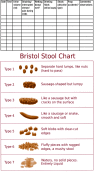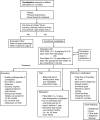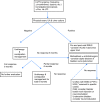Bladder and bowel dysfunction in children: An update on the diagnosis and treatment of a common, but underdiagnosed pediatric problem
- PMID: 28265323
- PMCID: PMC5332240
- DOI: 10.5489/cuaj.4411
Bladder and bowel dysfunction in children: An update on the diagnosis and treatment of a common, but underdiagnosed pediatric problem
Abstract
Bladder and bowel dysfunction (BBD) describes a spectrum of lower urinary symptoms (LUTS) accompanied by fecal elimination issues that manifest primarily by constipation and/or encopresis. This increasingly common entity is a potential cause of significant physical and psychosocial burden for children and families. BBD is commonly associated with vesicoureteral reflux (VUR) and recurrent urinary tract infections (UTIs), which at its extreme may lead to renal scarring and kidney failure. Additionally, BBD is frequently seen in children diagnosed with behavioural and neuropsychiatric disorders such as attention-deficit/hyperactivity disorder (ADHD) and autism spectrum disorder (ASD). Patients with concomitant BBD and neuropsychiatric disorders have less favourable treatment outcomes. Early diagnosis and treatment of BBD are critical to avoid secondary comorbidities that can adversely impact children's kidney and bladder function, and psychosocial well-being. The majority of patients will improve with urotherapy, adequate fluid intake, and constipation treatment. Pharmacological treatment must only be considered if no improvement occurs after intensive adherence to at least six months of urotherapy ± biofeedback and constipation treatment. Anticholinergics remain the mainstay of medical treatment. Selective alpha-blockers appear to be effective for improving bladder emptying in children with non-neurogenic detrusor overactivity (DO), incontinence, recurrent UTIs, and increased post-void residual (PVR) urine volumes. Alpha-1 blockers can also be used in combination with anticholinergics when overactive bladder (OAB) coexists with functional bladder outlet obstruction. Minimally invasive treatment with onabotulinumtoxinA bladder injections, and recently neurostimulation, are promising alternatives for the management of BBD refractory to behavioural and pharmacological treatment. In this review, we discuss clinical presentation, diagnostic approach, and indications for behavioural, pharmacological, and surgical treatment of BBD in children based on a thorough literature review. Expert opinion will be used when scientific evidence is unavailable.
Figures



Comment in
- Can Urol Assoc J. 11(1-2Suppl1):S73.
References
-
- Dos Santos J, Varghese A, Koyle M. Recommendations for the management of bladder bowel dysfunction in children. Pediatr Therapeut. 2014;4:1. https://doi.org/10.4172/2161-0665.1000191. - DOI
-
- Halachmi S, Farhat W. Interactions of constipation, dysfunctional elimination syndrome, and vesicoureteral reflux. Adv Urol. 2008:828275. https://doi.org/10.1155/2008/828275. - DOI - PMC - PubMed
-
- Kaplan S, Dmochowski R, Cash B. Systematic review of the relationship between bladder and bowel function: Implications for patient management. Int J Clin Pract. 2013;67:205216. https://doi.org/10.1111/ijcp.12028. - DOI - PubMed
-
- Jackson E. Urinary tract infections in children: Knowledge updates and a salute to the future. Pediatr Rev. 2015;36:153–64. https://doi.org/10.1542/pir.36-4-153. - DOI - PubMed
-
- Austin P, Bauer S, Neveus T. The standardization of terminology of lower urinary tract function in children and adolescents: Update report from the Standardization Committee of the International Children’s Continence Society. J Urol. 2014;191:1863–5. https://doi.org/10.1016/j.juro.2014.01.110. - DOI - PubMed
Publication types
LinkOut - more resources
Full Text Sources
Other Literature Sources
Research Materials
